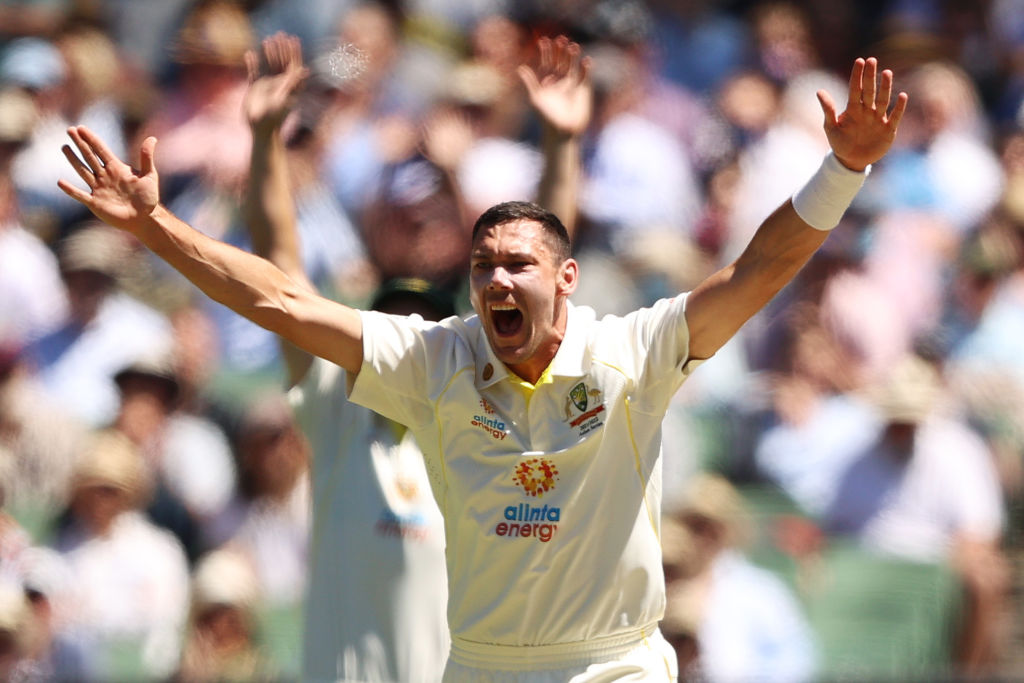With Australian staple fast bowler Josh Hazlewood suffering an injury, Scott Boland, Michael Neser and Lance Morris are the three back-ups in the 14-man squad to play South Africa.
Boland and Neser got the nod in the second test against the West Indies after both Hazlewood and captain Pat Cummins sat out, with Boland taking 0/29 and 3/16.
Never on the other hand took 2/34 and 3/22. Lance Morris is uncapped for Australia and was selected off the back of currently topping the Sheffield Shield for wickets with 27 and bowling over 150 kilometres per hour.
Commentators Mark Waugh and Isa Guha have tipped Boland to get the nod ahead of both in the first test against South Africa.
“I just think Boland is a better bowler than Neser – (he's) just a yard quicker,” Waugh said.
“I think I agree purely because I think Boland likes being first change, and Cummins will come in and open with Starc,” Guha said.
Waugh also suggested a potential debut for Lance Morris this series, thinking Melbourne could suit his bowling.
“He might play in Melbourne. I reckon he might be suited to Melbourne,” he said.
“Just because of the pitch. It's not a big swinging and seaming ground, so I think pace through the air might be useful in Melbourne.”
But what do the stats say?
On recent form, obviously Boland and Neser have the upper hand playing in Australia's recent series against the West Indies.

The overall bowling figures for Boland was 3/45, with Neser taking 5/56. Boland had an incredible economy of 1.81 and 1.60. This was a feature of his bowling when he debuted for Australia against England last summer.
He can frustrate batters by keeping the rotation of the strike to a minimum and applying serious pressure with his consistent line and length outside off-stump.
Neser on the other hand had an economy of 2.83 and 2.03. Also very solid and resulted in taking three more wickets than Boland in the match.
As for young 24-year-old pace gun Lance Morris, he has been in fine form in Shield cricket, bagging the most wickets in the competition with 27 to his name. He also boasts an overall economy of 3.33. His efforts have seen Western Australia top the ladder, not losing a game so far.
In his most recent game against Queensland, he took 2/61 in the first innings, and 3/22 with a 1.29 economy in the second. Beyond the first game, selections may differ, but for the first game in Brisbane, Boland will get the nod.
Boland has got the full package, he is faster than Neser (although not as much as Morris), but his consistency and economy is the best of the three. Boland also boasts more international appearances and has delivered some great bowling in spells.
The famous 6/7 spell against England during last year's Boxing Day Test, and his triple wicket maiden against the West Indies are his best work yet.
Boland seems to be the best all-round package. From his four Test matches played, his figures are off the charts with 21/217. These numbers leave Boland with an average of just 10.33, and an economy of just 2.02.
From Neser's two matches he has totalled 7/117. His average is also impressive with 16.71 and has a 2.49 economy. A comparison with these two players' stats to current Australian captain and current ICC fifth-best test bowler of all time Pat Cummins does provide some insight.
However, it is key to note Cummins figures are over many more games (44) than both Boland and Neser.
Cummins had 202/4345, with an average of 21.50 and an economy of 2.73. An economy of under three and an average in the 20s is generally considered to be excellent and an elite level of bowling, so Neser and Boland have been excelling so far.
As for Morris, in first-class cricket he has 59 wickets with a 25.08 average and a 3.64 economy. His impact when bowling is similar to the likes of Mitchell Johnson who over his career had a 28.40 average with an economy of 3.33.
The likes of Johnson and even England's Mark Wood have been hugely successful in Australian conditions, both Johnson and Wood being express pace bowlers like Morris.
Even if Morris does not get a call-up now, he definitely will be part of Australia's long-term vision. His pace and ferocity can bring any side unstuck and may birth another Johnson-like superstar in the long-term.







